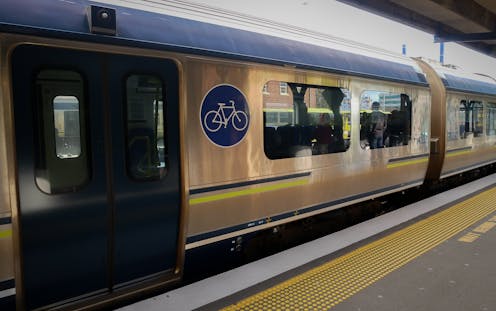Why restoring long-distance passenger rail makes sense in New Zealand -- for people and the climate
- Written by Robert McLachlan, Professor in Applied Mathematics, Massey University

A recent parliamentary inquiry[1] into passenger rail drew 1700 submissions, suggesting growing support for the return of long-distance trains in Aotearoa.
The government has committed the country to decarbonisation targets that require significant cuts to transport-related emissions. But decarbonising long-distance travel is not part of the plan – the national rail operator KiwiRail remains focused on freight.
We argue the revival of long-distance passenger rail needs to be part Aotearoa’s strategy to bring emissions down.
The arguments for intercity passenger rail centre on connecting communities, equity in transport options, reduced emissions and lower energy use.
The end of the decline?
After a long decline – detailed in André Brett’s history of the New Zealand network Can’t Get There From Here[2] – there were some gains in 2022.
Following initial plans to turn it into a tourist train, the Northern Explorer is back running between Auckland and Wellington. Passenger numbers on Te Huia, a rail service between Auckland and Hamilton, have doubled[3] – helped by half-price fares[4] – since its launch in April 2021.
The commuter train Capital Connection attracts good passenger numbers on its week-day only run between Wellington and Palmerston North, despite old and unreliable rolling stock. Work is underway on improving passenger rail near Wellington[5].
Campaigning for rail
Several new campaigns are pushing for further improvements to passenger rail.
Save Our Trains[6] is seeking a “comprehensive national strategy for inter-regional passenger rail services built around concerns for climate action, accessibility, affordability and economic development”.
Making Rail Work[7] has developed a proposal to reinstate the Kaimai Express linking Auckland and Tauranga. A report[8] for local government supported the case for more frequent services linking North Island towns.
Read more: Convenience, comfort, cost and carbon: what's the best way to travel, save money and cut emissions?[9]
Arguing for the restoration of the Auckland–Wellington night train, public transport planner Nicolas Reid[10] suggested such a service “would have the potential to replace up to 150,000 long-distance car trips or flights per year”.
Most controversially, the group Restore Passenger Rail[11] staged a series of nonviolent direct actions to draw attention to the issue, closing motorways and attempting[12] (unsuccessfully) to address the cross-party inquiry into passenger rail from the top of a motorway gantry.
Rail cuts transport emissions
Transport comprises 45% of Aotearoa’s domestic carbon dioxide emissions, but it is hard to decarbonise. It requires a combination of changes to technology, behaviour and infrastructure. But the significant emission and energy[13] benefits of using intercity and regional rail, rather than driving or flying, are well established globally.
New Zealand’s emissions reduction plan[14] aims for a 20% reduction (per capita) in driving by 2035, through improved urban planning and better travel options. But it does not mention intercity rail.
As half[15] of all kilometres driven are on the state highway network, this is a major omission. Auckland Council’s transport emission reduction plan also aims to reduce domestic aviation emissions by half[16] by 2030, before promised electric or hydrogen-powered planes[17] can make any real impact.
References
- ^ parliamentary inquiry (www.parliament.nz)
- ^ Can’t Get There From Here (www.otago.ac.nz)
- ^ doubled (www.tehuiatrain.co.nz)
- ^ half-price fares (www.beehive.govt.nz)
- ^ Wellington (www.beehive.govt.nz)
- ^ Save Our Trains (www.allrailways.co.nz)
- ^ Making Rail Work (makingrailwork.com)
- ^ report (www.ruapehudc.govt.nz)
- ^ Convenience, comfort, cost and carbon: what's the best way to travel, save money and cut emissions? (theconversation.com)
- ^ Nicolas Reid (www.greaterauckland.org.nz)
- ^ Restore Passenger Rail (restorepassengerrail.nz)
- ^ attempting (www.nzherald.co.nz)
- ^ energy (www.carbonbrief.org)
- ^ emissions reduction plan (environment.govt.nz)
- ^ half (www.nzta.govt.nz)
- ^ half (www.aucklandcouncil.govt.nz)
- ^ electric or hydrogen-powered planes (www.researchgate.net)
- ^ CC BY-SA (creativecommons.org)
- ^ Auckland (www.aucklandcouncil.govt.nz)
- ^ Wellington (wellington.govt.nz)
- ^ Christchurch (newsline.ccc.govt.nz)
- ^ Ōtaki and Levin (www.greaterauckland.org.nz)
- ^ extremely poor (www.nzta.govt.nz)
- ^ Climate explained: does building and expanding motorways really reduce congestion and emissions? (theconversation.com)
- ^ private coach network (www.researchgate.net)
- ^ poor take buses (inequalityintransport.org.uk)
- ^ take the bus (www.researchgate.net)
- ^ drivers’ licences (www.statista.com)
- ^ NZ’s most walkable towns and cities ranked: see how your neighbourhood stacks up (theconversation.com)

















